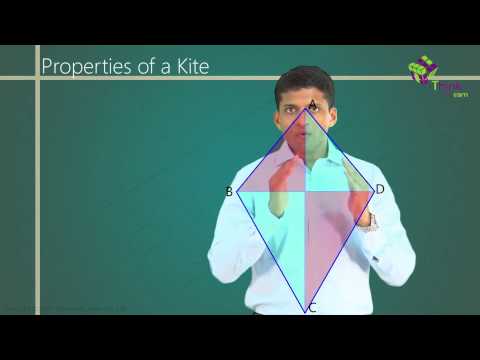
Quadrilaterals – Kite Properties:
A polygon is a plane figure which is bounded by finite line segments to form a closed figure. A 4-sided polygon is known as a quadrilateral.
The sum of interior angles of a quadrilateral is always 360°. The number of diagonals in a n-sided polygon is given by
Kite is a quadrilateral in which two pairs of adjacent sides are of equal length and the diagonals intersect each other at right angles. The figure shown below represents a kite.
The fig 1 above represents a quadrilateral and it can be represented as:
In quadrilateral ABCD, the sides AB = BC and AD = CD. Thus, as the adjacent pair of sides is equal in length, therefore ABCD is a special type of quadrilateral known as a kite.
Kite Properties:
- i) Diagonals intersect at right angles.
In a kite, the diagonals intersect at right angles. This can be proved as follows.
From fig. 2 above, in ∆ABD and ∆BCD
AB=BC
AD=CD
BD is common.
Therefore ∆ABD ≅ ∆BCD (SSS rule of congruency)
Also, in ∆ABC and ∆ADC
AB = BC and AD = CD
Thus, ∆ABC is an isosceles triangle.
⇒ ∠BAO = ∠BCO
Thus, ∆ABO ≅ ∆BCO (ASA rule of congruency)
⇒∠AOB = ∠BOC (CPCT)
Also, ∠AOB + ∠BOC = 180° (Linear pair)
⇒ ∠AOB = ∠BOC = 90°
(NOTE: CPCT stands for congruent parts of congruent triangle)
- ii) One of the diagonals is the perpendicular bisector of another.
As seen above ∆ABO ≅ ∆BCO and ∠AOB = ∠BOC = 90°
⇒ AO = OC (CPCT)
Thus BD bisects AC at right angles.
- iii) Angles between unequal sides are equal.
Since, ∆BAD ≅ ∆BCD
⇒ ∠BAD = ∠BCD (CPCT)
- iv) Area of a kite:
If length of both diagonals is given as p and q as shown in the figure given below, area (A) of kite can be given as:
A =
- v) Rhombus as a special case of kite:
If all the sides of a kite become equal in length then that kite becomes a rhombus as sides are of equal length and diagonals are perpendicular to each other.
Click to read about Parallelogram Properties and more.



Comments